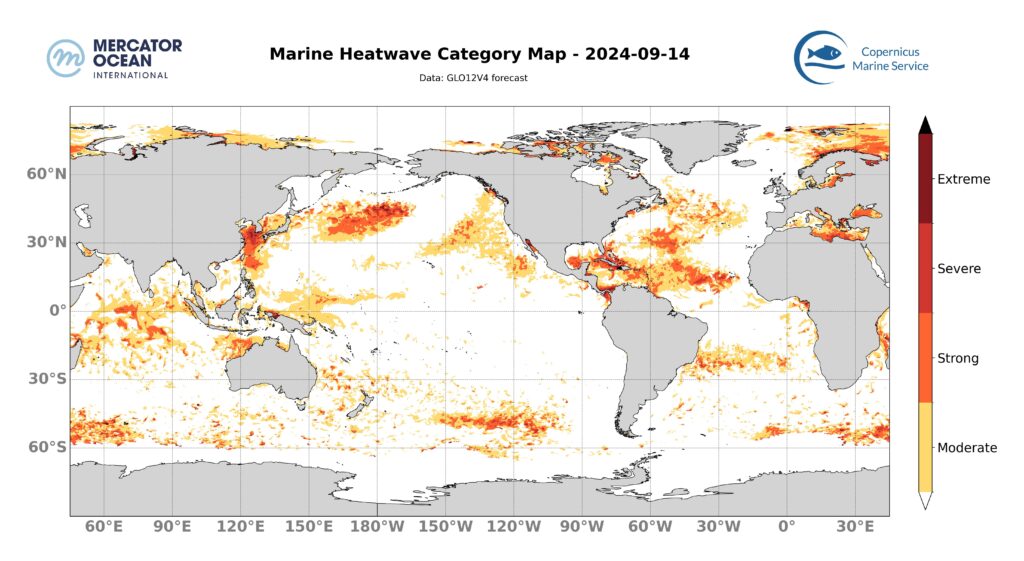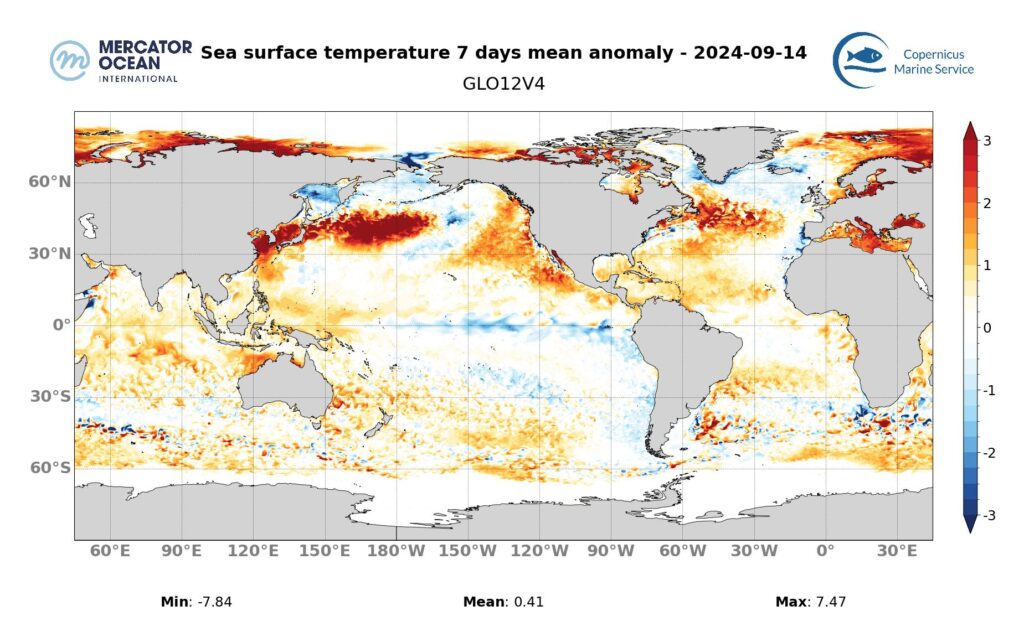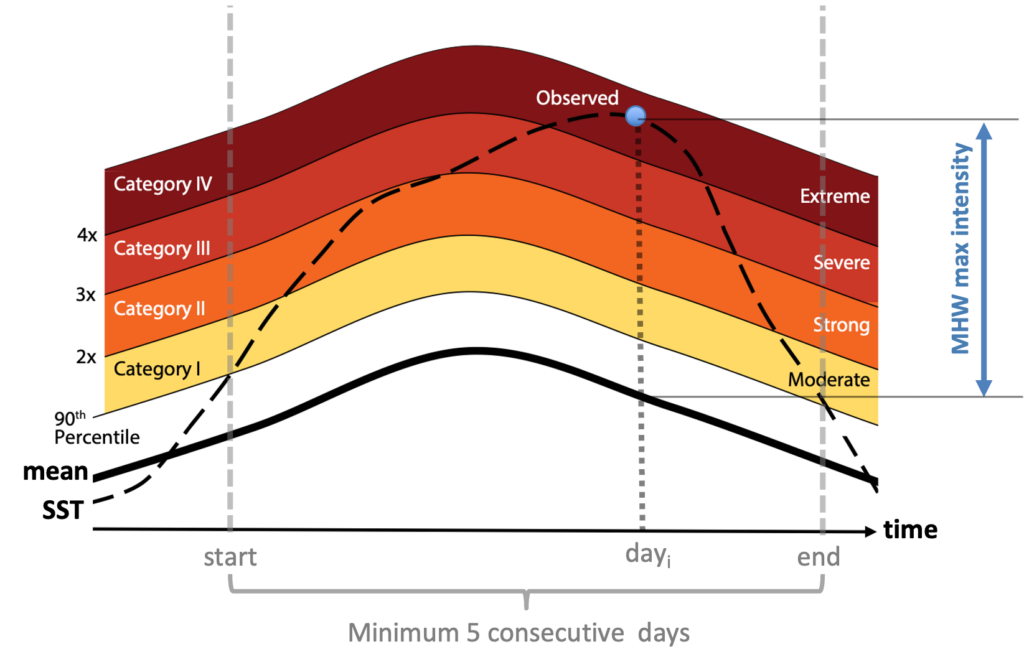Mercator Ocean International (MOi) oceanographers examine marine heatwaves across the global ocean. They analyse a variety of datasets from observations (satellite sea surface temperature maps) to numerical model analyses (assimilating satellite and in situ observations) and derive marine heatwave forecasts for a 7 day period.[1]
Forecasts for September 14th

Europe Zone
For the 14th of september, Mercator Ocean International (MOi) forecasts a weakening of the marine heatwave in the Mediterranean Sea.
In the western basin, the extent of the marine heatwave is strongly decreasing, and its intensity is changing from moderate and strong categories to mainly moderate and locally strong categories.
In the eastern basin, the intensity of the marine heatwave is decreasing, with some of the strong categories replaced by moderate categories.
In the southern Baltic Sea, the marine heatwave is intensifying, with a shift from the moderate to the strong categories along the coasts from Poland to Estonia.
In the Norwegian Sea, the extent of the marine heatwave is decreasing, as is its intensity. The strong to severe categories are replaced by moderate to strong categories, and locally severe categories.
The marine heatwave in the Bay of Biscay disappears entirely.
Global Ocean
Atlantic Ocean
North Atlantic Ocean – MOi forecasts that the marine heatwave in the mid North Atlantic is decreasing both in extent and intensity, with less moderate to severe categories.
North Tropical Atlantic Ocean – The extent of the marine heatwave is decreasing overall. Its intensity is decreasing in the Gulf of Mexico, with presence of strong to moderate categories only in the south. Nevertheless, its intensity is increasing along Panama, and around Cuba, with strong to severe categories for the most part, and locally extreme and more along the Haitian coasts.
South Tropical Atlantic Ocean – In the Southern Tropical Atlantic, the marine heatwave decreases in extent, we’re still observing mainly moderate categories.
Southern Ocean
The marine heatwave in the Southern Ocean, off the South African coast (between 30°W and 30°E) remains stable.
Pacific Ocean
Tropical Pacific Ocean – In the Tropical Pacific, the marine heatwave in the north of Papua New Guinea is strongly decreasing in both area and intensity, moving into moderate categories overall.
Off the coast of Mexico, the marine heatwave is also decreasing in extent and intensity, mostly in moderate category. However, a marine heatwave of strong to severe categories is observed in the Gulf of California.
North Pacific Ocean – In the North Pacific, the marine heatwave in the center of the basin, towards 180°W, is increasing in intensity, with more strong categories and locally with severe to extreme categories.
Between the North American coasts and towards 180°W, the marine heatwave is decreasing in intensity, with a reduced extent of strong categories. The marine heatwave in the Sea of Japan and East China Sea increases in intensity, with strong, severe and locally extreme categories.
South-East Asian Seas – Marine heatwaves in the Southeast Asian seas continue to decrease in intensity and have almost disappeared, with only a few moderate marine heatwaves left.
South Pacific, to the east of New-Zealand – In the South Pacific, to the East of New-Zealand, the marine heatwave remains stable.
Indian Ocean
In the Indian Ocean, Mercator Ocean forecasts that the intensity and extent of the marine heatwave continues to decrease, moderate and strong categories are observed at the center of the basin.
Weekly temperature anomalies

| Atlantic Ocean | North 1.5°C to 3°C | North Tropical 0.5°C to 1.5°C | South Tropical 0°C to 1°C | |
| Southern Ocean | 0°C to 2°C | |||
| Pacific Ocean | North 0°C to 3°C | Tropical -2°C to 2.5°C | South 0.5°C to 1.5°C | South-East Asian Seas 0°C to 0.5°C |
| Indian Ocean | 0.5°C to 2°C |
Consult our Daily Global Physical Bulletin for a 9-day forecast here.
What are marine heatwaves?
Marine heatwaves (MHW) are extreme rises in ocean temperature for an extended period of time. They can occur at different locations in the ocean, and their magnitude and frequency have increased over the last couple of decades, with harmful impacts on ecosystems, and human activities. According to the latest report released by the Intergovernmental Panel on Climate Change (IPCC AR6 SYR), it is found with high confidence that in the near-term at 1.5°C global warming, the increasing frequency of marine heatwaves will increase risks of biodiversity loss in the oceans, including from mass mortality events.[2]
How are marine heatwaves calculated?
A marine heatwave is an episode during which the ocean temperature is abnormally warm for at least 5 consecutive days.

Figure adapted from Hobday et al. (2018)
For any location in the ocean, the normal temperatures are defined for every day of the year using a climatological period (here 1993–2016). A heatwave is identified when the measured daily temperature is within the top 10% of the highest recorded values for that day (i.e., above the 90th percentile, see diagram), and with this condition persisting for at least five consecutive days.
The intensity of the heatwave on any given day is measured as the number of degrees above the climatological average (represented by the bold black line) indicated by the blue arrow. We can either calculate the cumulative intensity over the entire heatwave or record the maximum intensity.
Heatwaves are classified based on their intensity level. To do this, the intensity is compared to the difference between the climatological value and the 90th percentile value. A mhw intensity between 1 and 2 times this difference corresponds to a heatwave of moderate category; between 2 and 3 times, to a strong category; between 3 and 4 times, to a severe category; and a difference greater than 4 times corresponds to an extreme category.
[1] Analysis of datasets: SST OSTIA (Copernicus Marine Service), OISST (NOAA), GLO12 (Copernicus Marine Service / Mercator Ocean International), PSY4 (Copernicus Marine Service / Mercator Ocean International), and GLO12 et PSY4 forecasts.
[2] IPCC AR6 SYR chapter 4.3 https://www.ipcc.ch/report/ar6/syr/downloads/report/IPCC_AR6_SYR_LongerReport.pdf
